| Vivian (Bullwinkel) Statham AO MBE RRC is managed by the Australia Project. Join: Australia Project Discuss: australia |
Biography
[1][2][3] Vivian Bullwinkel, AO, MBE, ARRC, ED, FNM ,was an Australian Army nurse. On 16 February 1942, Japanese soldiers killed 21 nurses on Radji Beach, Bangka Island, Indonesia. This was later known as the Bangka Island Massacre. Vivian Bullwinkel was the only survivor.

|
Vivian Bullwinkel was born on 18 December 1915 in Kapunda, South Australia. Her parents were George and Eva Bullwinkel née Shegog. George had migrated to Australia from Essex England in 1912. Vivian moved to Broken Hill, New South Wales where she started her training as a nurse and midwife. Once she had finished her training, she moved to Hamilton, Victoria, then moved to the Jessie McPherson Hospital in Melbourne in 1940.
Vivian volunteered for the Australian Army Nursing Service in May 1941 and she was assigned to the 2/13th Australian General Hospital. She left for Malaya on the hospital ship Wanganella. The hospital shifted to Singapore in January 1942, after the Japanese invasion of the Malay Peninsula. Vivian and 65 other nurses were the last of 130 Australian nurses to flee Singapore before it fell. They left on the HMS Vyner Brooke , [4] 2 days later on the 14th of February, after the ship had been hit repeatedly by Japanese aircraft. It received three direct hits and the HMS Vyner Brooke was sunk.
Twelve Australian nurses were either killed in the attack on the ship or drowned in the sea, but 22 nurses and a number of passengers, including women and children, made it ashore to Radji Beach on Banka Island. They decided to surrender to the Japanese. Some civilian women and children had left already to find local authorities to whom they might surrender. The nurses were protected under the Geneva Convention, as they were non-combatant medical officers. Some even still had their Red Cross armbands on their uniforms, but this made no difference to the Japanese soliders. 100 British soldiers also joined them on the beach. The Japanese soldiers killed the men and the nurses were ordered into the sea, where they were machine gunned from behind. Vivian Bullwinkel was hit by a bullet and was badly wounded. She was still alive and pretended to be dead until the Japanese had left. After the war this became known as the Banka Island Massacre.
From Battle of Australia - Recollection's of a survivor - Sister Vivian Bullwinkel's Story in her own words
I think by this time we'd had shock added to everything else. The Japanese came and stood in front of us and indicated that we should go into the sea. And we walked into the sea with our backs to them. We knew what was going to happen to us, but all I can remember thinking was, I am sorry Mother will never know what has happened to me but it will be nice to see Dad again. We didn't talk among ourselves. It was quite silent. We were drained of emotion. There were no tears. Perhaps I was thinking, How can anything as terrible as this be happening in such a beautiful place?I'm not sure I heard the shooting . . . yes, I think I did hear a rat-tat-tat and I suppose it was a machine-gun. I got hit. The force of the bullet, together with the waves, knocked me off my feet. I just lay there, swallowing a tremendous amount of salt water until I was violently ill. And, after a while it sort of penetrated that I wasn't dying right there and then. I thought I'd better stay low until I couldn't stay low any longer. The waves brought me right into the shallow water.
Finally, when I did sit up and look around, there was nothing. The Japanese had gone and none of the girls were to be seen.. nothing. It's a bit hard to say but I think it might have been just after midday. I started to shiver and all I wanted to do was get up into that jungle and lie down. So I got up and walked across the beach and lay down just off a track that led to the nearest village. Whether I passed out or not, I don't know . . . but I know that I woke up on one occasion and it was pitch dark.
On the second occasion it was daylight, and I was hot and sticky and felt awful. All I could think about was that I must get up and go down to the spring at the beach and get a drink. But I couldn't be bothered. So I lay down again, and for a while there wasn't a sound. And suddenly, to my horrified gaze, I saw a line of helmets and bayonets going down towards the beach. I don't know how long I lay there flat, but eventually they came back again and I swear I looked into every pair of eyes. If I'd gone out for a drink when it was my first inclination, that would have been the end.
Well, I finally got up enough courage to go down and have a drink. Suddenly a voice from behind said, Where have you been, nurse His name was Kingsley and he was the only man still alive from the British soldiers bayoneted on the beach. He had the top part of an arm blown off (when the ship was attacked) and a wound through his abdomen from the bayonet. And they faced each other, this dreadfully injured Englishman and the tall Australian nurse with a bullet hole through the left side of her body. He had managed to get to a fisherman's hut after the slaughter. I said, What do we do from here he didn't know what to do so we had a drink and then we had our first argument.
I said, I'm going back to the jungle, because I had faith in the jungle after that episode. He said, No, I'm going back to the fisherman's hut. But he gave in and went into the jungle while I went down to the beach and picked up a few water bottles at the spring. I brought them back to him and made him comfortable. He wasn't in too good a state.
I got some bark from the trees and wrapped them around his wounds . . . My own wound Oh, yes! Well, it wasn't too bad at all! I could tell from the holes in my uniform that the bullet had come out. I wondered how it had managed to miss my intestines, my liver and my stomach . . although people have said since that it probably missed my intestines and stomach because they were shrunk through lack of food. And people have said that if I weren't so tall, of course, the bullet would have passed right through my heart. I didn't give my wound any attention at all and as the days passed, I felt myself getting stronger. Oh, I watched it in case of infection but I think the fact that I spent so many hours in the salt water had cleaned it out.
Look, if I'd been near a hospital they'd probably have taken me in, opened it up and made it a lot worse with their probing around! But, left to nature, it healed beautifully
After Vivian found the wounded British Private, they hid together for 12 days before deciding to surrender. They were taken as prisoners of war; the private died. Vivian was sent to the same POW Camp as the rest of the survivors of the SS Vyner Brooke. She told them secretly of the massacre but it was not mentioned again until after the war. The Japanese did not know Vivian had survived the massacre; if they had found out, it would have put her life in danger. Because of this, she also hid her wounds from the Japanese. Vivian spent three and half years in captivity. She and many others suffered hardship and brutality in a series of prison camps on Bangka Island and in Sumatra. The nurses buried eight of their friends, who had died from malnutrition, ill treatment, and disease. On 11 September 1945, the nurses were rescued from the POW camp and flown to Singapore.
After being freed, Vivian's story was told on the front page of all the newspapers, causing outrage and anger at the treatment of the women. She gave evidence of war crimes at the Tokyo Tribunal. The Japanese officer thought to have ordered the massacre committed suicide and a camp commandant was sentenced to 15 years’ imprisonment. Just 24 of the 65 nurses who had been on the Vyner Brooke had survived the war and Vivian (or Bully as she was known) was one of these.
Vivian served in Japan in 1946 and 1947 before resigning from the Army as Captain. She rejoined the Citizen Military Forces in 1955 and served until 1970, when she retired with the rank of Lieutenant Colonel. Vivian was Matron of Fairfield Infectious Diseases Hospital, on the banks of the Yarra River at Yarra Bend in the inner Melbourne suburb of Fairfield, for 16 years and Director of Nursing there until retiring in 1977. After she retired, The Vivian Bullwinkel School of Nursing was opened at the hospital in her honour. She married Colonel F.W. Statham in 1977. She was a member of the Council of the Australian War Memorial, and president of the Australian College of Nursing. Vivian returned to Banka Island in 1992, to unveil a shrine to the nurses who died there.
Vivian was appointed to the [5] Order of Australia AO 26 January 1993, and appointed a [6] Member of the Order of the British Empire MBE 1 January 1973. She was awarded the [7][8]Royal Red Cross Medal 6 March 1947 for service to the veteran and ex-prisoner of war communities, to nursing, to the Red Cross Society, and to the community. She was also the winner of the Florence Nightingale Medal.[9]
Vivian Bullwinkel died of a heart attack on 3 July 2000. She was 84 years old. Vivian was given a State Funeral on Monday 10 July 2000 at St George’s Anglican Cathedral, St George’s Terrace, Perth.
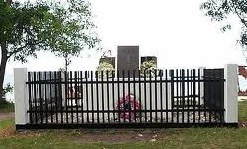
|
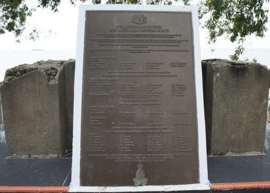
|
Memorial to Australian nurses on Bangka island , Never forgotten
Vivian Bullwinkel
WWII Honours
![]() Officer of the Order of Australia (AO)
Officer of the Order of Australia (AO)
Member of the Order of Australia (AM)
![]() Member of the Order of the British Empire (MBE)
Member of the Order of the British Empire (MBE)
![]() Associate Member of the Royal Red Cross (ARRC)
Associate Member of the Royal Red Cross (ARRC)
![]() Australia Service Medal 1939–45
Australia Service Medal 1939–45
![]() Florence Nightingale Medal (Red Cross)
Florence Nightingale Medal (Red Cross)
- The National Pioneer Women’s Hall of Fame | HerStory Home/Search
- HerStory : First female Trustee of Australian War Memorial.
latest honour
Vivian continues to be commemorated 74 years after the end of the Second World War. Enoggera, Queensand's Gallipoli Barracks re-named the 17th Brigade precinct to Bullwinkel Lines on 13th September 2019. The precinct provides combat health support to the army, so the naming is appropriate. The re-naming and unveiling of a stone monument caused Vivian's nephew, John Bullwinkel, to reflect, "This ceremony and memorial recognises Vivian's life's work and reflects her strong connection to the Army. The personnel here at 17 Brigade are continuing Vivian's work in health, which was her passion in life."[10]
Sources
- ↑ DutchEastIndies.com - The Bangka Island Massacre, February 1942 Black day in the history of Imperial Japanese Army
- ↑ Trove Digitised Newspapers - massacre of Nurses on Banka Beach - The Argus Melbourne 19 September 1945
- ↑ The Sydney Morning Herald - Stoic nurses stared down an atrocious death The courage of marooned World War II nurses in the face of slaughter still resonates, writes Steve Meacham.
- ↑ angellpro.com.au - The sinking of the "SS Vyner Brooke" A collection of Eye-witness Accounts
- ↑ Its a Honour - Name - STATHAM, Vivian Award - Officer of the Order of Australia Date granted-26 January 1993 Citation - AO MBE ARRC ED. AO/FOR SERVICE TO THE VETERAN AND EX-POW COMMUNITIES, TO NURSING, TO THE RED CROSS SOCIETY AND TO THE COMMUNITY. (JAN 93) AUST DAY HONOURS
- ↑ Its a Honour - Name - BULLWINKEL, Vivian Award: The Order of the British Empire - Member (Civil) Date granted - 01 January 1973 Citation - In recognition of service to nursing and the community
- ↑ Its a Honour - Name - BULLWINKEL, Vivian Award - Royal Red Cross (2nd Class) Date granted - 06 March 1947
- ↑ Trove Digitised Newspapers - Awards to brave nurses PRESENTATION of the Florence Nightingale medal was made yesterday by Sir John Latham, Chief Justice illustrated The Argus Melbourne Thursday 24 July 1947
- ↑ Telegraph Obituaries - Vivian Bullwinkel 17 July 2000
- ↑ Defence Newspapers, Army: The Soldier's Newspaper, edition 1451 3 Oct 2019, Findlay-Williams, Tobias: War-time Nurse Honoured; accessed 1 Oct 2019
- Find A Grave Index," database, FamilySearch (https://familysearch.org/ark:/61903/1:1:QK18-M5RS : 11 July 2016), Vivian Bullwinkel Statham, 2000; Burial, Perth, , Western Australia, Australia, Karrakatta Cemetery and Crematorium; citing record ID 141849624, Find a Grave, http://www.findagrave.com.
See also
- National Library of Australia - Bullwinkel, Vivian (1915-2000) Australian Women's Register
- Australian War Memorial - Fifty Australians Vivian Statham (née Bullwinkel), AO, MBE, ARRC, ED (1915–2000) Australian army nursing sister and prisoner of war. A victim of a war atrocity, Bullwinkel was the sole survivor when a group of nurses were machine-gunned by their Japanese captors.
- ABC.net.com - Vivian Bullwinkel - An Australian Heroine
- Battle for Australia - Recollection's of a survivor - Sister Vivian Bullwinkel's Story
- nnaa gov.au - Vivian Bullwinkel's citation for award of ARRC 22 March 1946 nurses, medals, military service, World wars, heroines, prisoners of war, citations, official documentation, bravery, courage, heroism, duty, World War II, Second World War, wartime stories, Associate of the Royal Red Cross Award
- Nurses Info - Vivian Bullwinkle Born in Kapunda, South Australia, 18th December 1915
- DBpedia.org - Vivian Bullwinkel, Mrs. Statham, AO, MBE, ARRC, ED, FNM (18 December 1915 – 3 July 2000) was an Australian Army nurse during the Second World War. She was the sole survivor of the Banka Island Massacre, when the Japanese killed 21 of her fellow nurses on Radji Beach, Bangka Island on 16 February 1942.
- DBpedia.org - The Royal Australian Army Nursing Corps (RAANC) is a Corps of the Australian Army. It was formed in February 1951 from the Royal Australian Army Nursing Service. A Corps Badge was introduced in 1951 with the motto Pro Humanitate (for Humanity). It embraces the values of compassion and service to others, reflecting the care and dedication provided to the wounded and sick. Approval for the Corps flag was granted on 7 February 1958.
- Australia.gov.au - Behind the Wire Australia's War 1939 - 1945
- Trove Digitised Newspapers - Illustrated News Adelaide Tuesday 6 November 1945 TODAY'S HAPPY CLOSE-UP of Sister Vivian Bullwinkel, of Fullarton, on her return in the Melbourne express after having been a prisoner of war in Japanese hands. Sister Bullwinkel is the sole survivor of the Japanese massacre of 21 Army nurses.
- Anzac Day - Bangka Island by Judith Spence
- Wikipedia - Vivian Bullwinkel
- Flickr.com - Nephew, John Bullwinkel, donating her medals to the Australian War Memorial (Flickr.com)
- Visit : VWMA Virtual Memorial Vivian Bullwinkel AO MBE . . . and photo . .
- Australian Nurses of the Vyner Brooke
https://www.abc.net.au/news/2022-12-16/first-woman-to-be-honoured-with-war-memorial-statue/101784378
No known carriers of Vivian's ancestors' DNA have taken a DNA test.
Have you taken a DNA test? If so, login to add it. If not, see our friends at Ancestry DNA.
Vivian is 25 degrees from Emeril Lagasse, 23 degrees from Nigella Lawson, 18 degrees from Maggie Beer, 43 degrees from Mary Hunnings, 30 degrees from Joop Braakhekke, 35 degrees from Michael Chow, 26 degrees from Ree Drummond, 21 degrees from Paul Hollywood, 25 degrees from Matty Matheson, 27 degrees from Martha Stewart, 36 degrees from Danny Trejo and 31 degrees from Molly Yeh on our single family tree. Login to find your connection.
B > Bullwinkel | S > Statham > Vivian (Bullwinkel) Statham AO MBE RRC
Categories: Australia, Notables in the Public Service and Professions | Australia, Profile Improvement - Military | Australia, Project Managed Profiles | This Day In History December 18 | This Day In History July 03 | This Day In History February 16 | Officers of the Order of Australia | Members of the Order of the British Empire | Royal Red Cross | Efficiency Decoration | Florence Nightingale Medal | 1939-1945 Star | Pacific Star | War Medal 1939-1945 | Australia Service Medal 1939-1945 | Nominated Profiles | Women in World War II | Australia, Nurses | 2nd 13th General Hospital, Australian Army, World War II | Kapunda, South Australia | Roll of Honor Military Showcase Profile Nominee | Victorian Honour Roll of Women | Featured Connections Archive 2021 | Australia, Notables in the Military | Notables | Wounded in Action, Australia, World War II | Prisoners of War, Australia, World War II



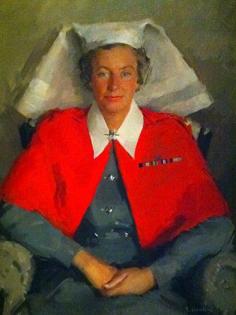
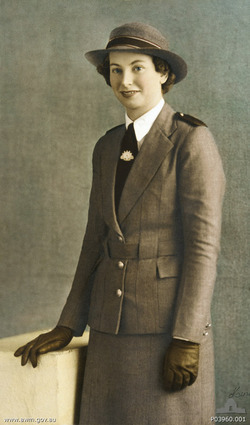
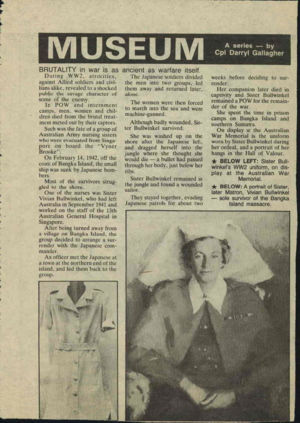
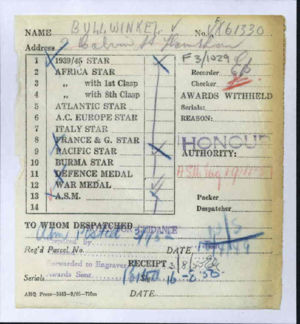
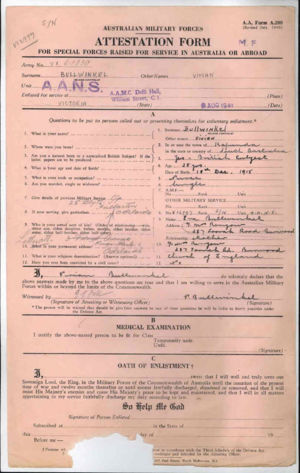
Thanks for your comment & question. I believe the whole "what counts as ANZAC?" question has appeared more than once in the G2G posts. It's open to interpretation because it refers to Australian & New Zealand forces that initially travelled together during the 1st world war but then later were referred to as ANZAC during the 2nd World War. How & when the term is used has become 'very open' in interpretation.
I hasten to add that there are other WT experts with a close interest in military specifically & to whom attaches there own specific opinion regarding ANZAC. In closing though the question was not wasted. Keep up your good work.
edited by Doug Laidlaw
Isn't it interesting the various things we hold in mind? You mentioned the Kiwi perspective, but the size of the contingent of brave young men from New Zealand doesn't seem to me to have been the cause of ANZAC... I read somewhere that the NZ govt wanted to ensure their troops were well protected from enemy submarines in the journey to Europe. Australians had the same desire so it made practical sense to combine them in a common convoy with ships who could defend it. Of course by the time the convoy arrived safely the troops had gotten to know each other well. And I guess (having similar pasts/lifestyles while being a part of the British Empire too) could relate to each other well. The rest is history I guess.
We are featuring this profile in the Connection Finder this week. Between now and Wednesday is a good time to take a look at the sources and biography to see if there are updates and improvements that need made, especially those that will bring it up to WikiTree Style Guide standards. We know it's short notice, so don't fret too much. Just do what you can.
Thanks!
Abby